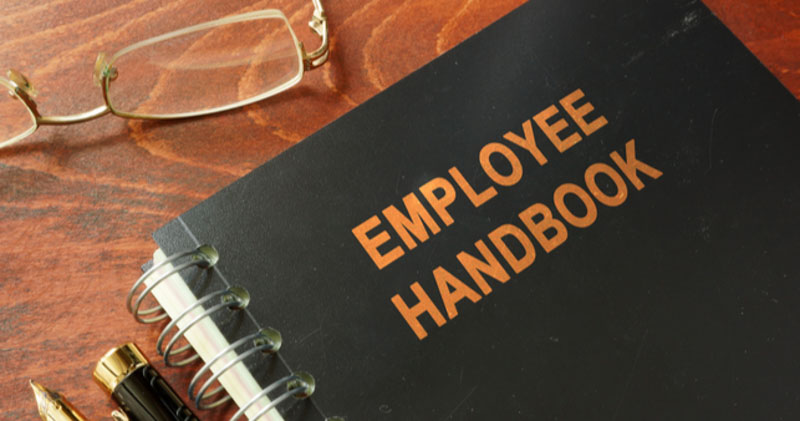
What is an Employee Handbook?
Also known as a staff manual and business handbook, an employee handbook is a document given to employees which outlines your company’s policies, culture, and expectations of behaviour and performance in the workplace.
An employee handbook is a great way to induct new staff into your organisation and gives existing staff a document they can reference at any time to keep their knowledge of workplace policies and procedures up to scratch.
Employee handbooks should be written to meet the specific needs of your business and the industry in which you operate.
Customise Your Company Policies
Every employee has a different background and their own set of experiences that inform their ideas of what is appropriate in a workplace. The Employee Handbook should set the standard and educate your employees to get everyone on the same page. Depending on your business and the industry you are in the handbook can look very different from company to company. A popular way to get the key messages across is a slideshow, especially for employee induction purposes, rather than employees having to wade through realms of paper. You can intersperse it with e-learning modules to really drive your point home. It is always good to back it up with a document though, as it is handy for employee reference purposes.
BrightHR allows you to store employee profiles and key documents such as contracts and handbooks securely in the cloud and determine employee access. You can upload updated polices and handbooks, set reminders and notifications of key dates, and get read receipts once your employees have accessed the latest version.
Make sure you have the basics covered in the handbook in terms of essential policies and procedures, such as a reflection of the current company culture, workplace policies and procedures, company expectations and standards of behaviour, and key onboarding information. But you can also include policies specific to your business, such as contact centre etiquette, customer complaint handling procedures, and polices concerning shiftwork for example, provided they meet any legislative requirements.
Get Workplace Advice Now
Employsure can help you understand more employee handbooks and implementing policies.
Set Expectations From the Beginning
Company policies and procedures can help set clear expectations as to what standard of behaviour and level of performance is expected from employees and are good tool to introduce as part of the induction process. It is a good idea to go through the key aspects of the Employee Handbook as part of an new employee’s induction rather than just let them to read it themselves. This ensures that the employee is familiar with the document and its content. It also allows employees to ask questions if something is not clear.
It is also a tool to manage employee expectations as to what they can expect from you in terms of reward and recognition, ongoing training and development, but also in what circumstances disciplinary action may be taken or what will happen if the employee makes a complaint.
BrightHR and BrightSafe offer online learning modules that you can use to train staff particularly in respect of their health and safety obligations.
There are many good reasons to have an employee handbook though. Many employers like them because they help to clarify expectations and reduce misunderstandings at work.
What Should You Include In Your Employee Handbook?
How you choose to structure the contents of your employee handbook is entirely up to you. The kind of information you include will depend greatly on the size of your company, the industry you specialise in, and the tone or style you use to communicate with your employees.
Regardless of your approach, there are certain details that every company should include in their employee handbook. Here are some of the following terms you may wish to address in your document:
Welcome note and information for new staff
Background and culture of the company
Mission and vision statements
Code of conduct and standards of behaviour
Workplace procedures
Grievance procedures
Equal opportunity policies
Hours of work
Performance standards
Disciplinary Procedures
Internet, social media and email policies
Confidential information and privacy policies
Rules of company
Training and development
Use of company property policies eg. vehicles or laptops
Outside of these guidelines, you may also inform your staff on employment policies and procedures that relate to your business. If it is a new policy or amendment that constitutes a major workplace change than consultation may be required depending on the relevant industrial instrument. Don’t simply copy and paste policy templates that you find online. Make sure the terms you include are relevant to your business and the industry you are involved in.
Below are some of the most common policies and procedures to clarify in your employee handbook:
Equality or equal opportunity policy
Internet, email and social media (or IT) policy
Use of company property policy
Disciplinary and grievance procedure
Resignation procedure
Updating Your Employee Handbook
An employee handbook is not something you write once and set aside. You may need to update the handbook in response to internal changes in the company itself.
Consider having a provision in the employee’s employment contract or Handbook that states that the Employment Handbook does not form part of the contract, and that the Employment Handbook itself allows the employer to update or modify the policy at any time. Ideally you should review, revise and recirculate your employee handbook when required.
If necessary, you can also host a training or info session to verbally communicate these changes, and take questions from staff to clarify details they are unsure about.
Employsure can help you draft workplace policies, procedures and documents such as a Handbook. Call us for free initial advice on 1300 651 415.

Get Workplace Advice Now
Employsure can help you understand more employee handbooks and implementing policies.
Frequently Asked Questions
Is An Employee Handbook A Legal Document?
As an employer you have a legal responsibility to inform your employees of their rights and responsibilities. However, there is no federal or state law that requires you to have an employee handbook.
There are many good reasons to have an employee handbook though. Many employers like them because they help to clarify expectations and reduce misunderstandings at work. Another benefit for employees is they can clearly see the benefits and compensations they are entitled to receive.
An employee handbook can help in the event of an employee claim. Depending on the case itself, if you can prove that an employee knew the standards and expectations of their role, you may be able to increase your chances of successfully defending a claim.
How Important Is An Employee Handbook?
There are many good reasons to have an employee handbook. Most importantly, they help to set standards of behaviour and clarify expectations to reduce misunderstandings at work.
Do Small Businesses Need An Employee Handbook?
Every business should have a handbook to set standards and expectations for the workplace and make sure key policies are communicated consistently across the workplace.
What Is The Difference Between Employee Handbook And Policy Manual?
An employee handbook contains more than a policy manual, as it provides information about the company culture and values and can showcase the benefits that the company offers.
What Should Be Included In An Employee Handbook?
- General employment information and policies and a Code of Conduct
- Discrimination, bullying and harassment policies and grievance procedures
- Equal opportunities policy
- Health and safety policies, procedures and information
- Leave policies and procedures
- Performance standards and training and development opportunities
- Disciplinary, termination and redundancy policies
- Confidential information, privacy and internet and email policies
- Company equipment policies eg. company mobile phone policy
How Much Does It Cost To Create An Employee Handbook?
It doesn’t have to cost anything, you can create one yourself, however it is a good idea to have it checked by a professional to make sure the content is fit for purpose. This will likely involve some cost.
Can I Add Documents To The Handbook?
Yes, you can add documents to the handbook if there is a provision that allows you to make changes, and the handbook does not form part of the employee contract. You may want to issue stand-alone policies from time to time though as every time you add or amend a policy you will need to reissue the handbook to all employees.
Can An Employer Change The Employee Handbook?
As long as your handbook does not form part of the employees’ employment contracts, you can change your employee handbook when needed. However, you will need to notify your employees of any policy changes, and if the changes are major, consultation may be required.
This blog has been compiled on the basis of general information current at the time of publication and reflects an opinion only and is not intended to provide anything other than an opinion at any time. Your specific circumstances as well as any changes in circumstances after publication may affect the relevance, completeness or accuracy of this information. To the maximum extent permitted by law, we disclaim all liability for any errors or omissions contained in this information or any failure to update or correct this information. It is your responsibility to assess and verify the accuracy, completeness, currency and reliability of the information on this website, and to seek professional advice where necessary. Nothing contained on this website is to be interpreted as a recommendation to use any product, process or formulation or any information on this website. For clarity, Employsure does not recommend any material, products or services of any third parties.










